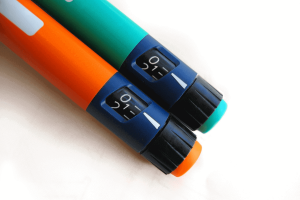The Ins & Outs of Blood Sugar
What is blood sugar and why does it matter so much?
Blood sugar monitoring is important for your diabetes care. Blood sugar (or blood glucose) is a measurement of the amount of sugar that is currently in your blood. Being too high or too low can lead to complications that can be serious in the long run. Your health care team needs these numbers so that they can change your medication regimen, including insulin doses, in order to keep you from experiencing the symptoms. Consistent levels of high blood sugars can also lead to further complications down the road like foot ulcers, loss of vision, and increased risk for heart problems.
How can you check your blood sugars at home?
There is a sweet spot of not too much but not too little sugar in the blood. The best way to try to achieve this sweet spot is to check your blood sugars at specific times throughout the day. There are a couple of ways that you can check your blood sugars:
- Typical Blood Glucose Monitoring – this involves pricking your finger with a lancet, placing the blood on a test strip, and inserting the strip into a meter to read your blood sugar level. These systems include FreeStyle Lite, OneTouch Verio, and more that you use at home to keep track of their sugars.
- Continuous Glucose Monitoring – this is a sensor that you place on your body for anywhere from 10 to 14 days and it continually reads your sugar levels and reports them back to the reader. Using these devices means you don’t have to continually stick your finger, the sensors check for you. With these you do have to remember to upload the data in a certain time frame depending on the device. The data uploads onto a website where your providers can see what your blood sugars are 24/7. Some examples are FreeStyle Libre and Dexcom CGM System.
So now you know how to check your blood sugars, but what do the numbers actually mean?
The American Diabetes Association (ADA) has blood sugar goals, depending on the time of day when you are testing.
-
- Before meals: 80 – 130 mg/dL
- After meals: less than 180 mg/dL
- Bedtime: 90-150 mg/dL
Sometimes it takes hard work to get you to these levels, but don’t let that bring you down! The Iowa Diabetes Portal is a great resource for information, tracking tools, and advice on your diabetes care. Or you could be seen at Iowa Diabetes Care, where you receive personalized diabetes care from a team of diabetes experts! This team works hard behind the scenes of your doctor visits, from pharmacists to prescribe you the meds that are right for you, to dietitians who help you improve your levels through food choices. These are trained professionals who help guide you into taking control and living a healthier life.
Summary
Having a detailed record of your blood sugar will better prepare you for your day-to-day diabetes management. You should always document your diet, blood sugar, and other routines to get to the bottom of what may cause problems or complications in your diabetes management.
Disclaimer Statement: This is for educational purposes only and not intended as medical advice. For individual medical advice, contact your healthcare practitioner.




